Alexander Lamden: “Any piece of iron has a character”
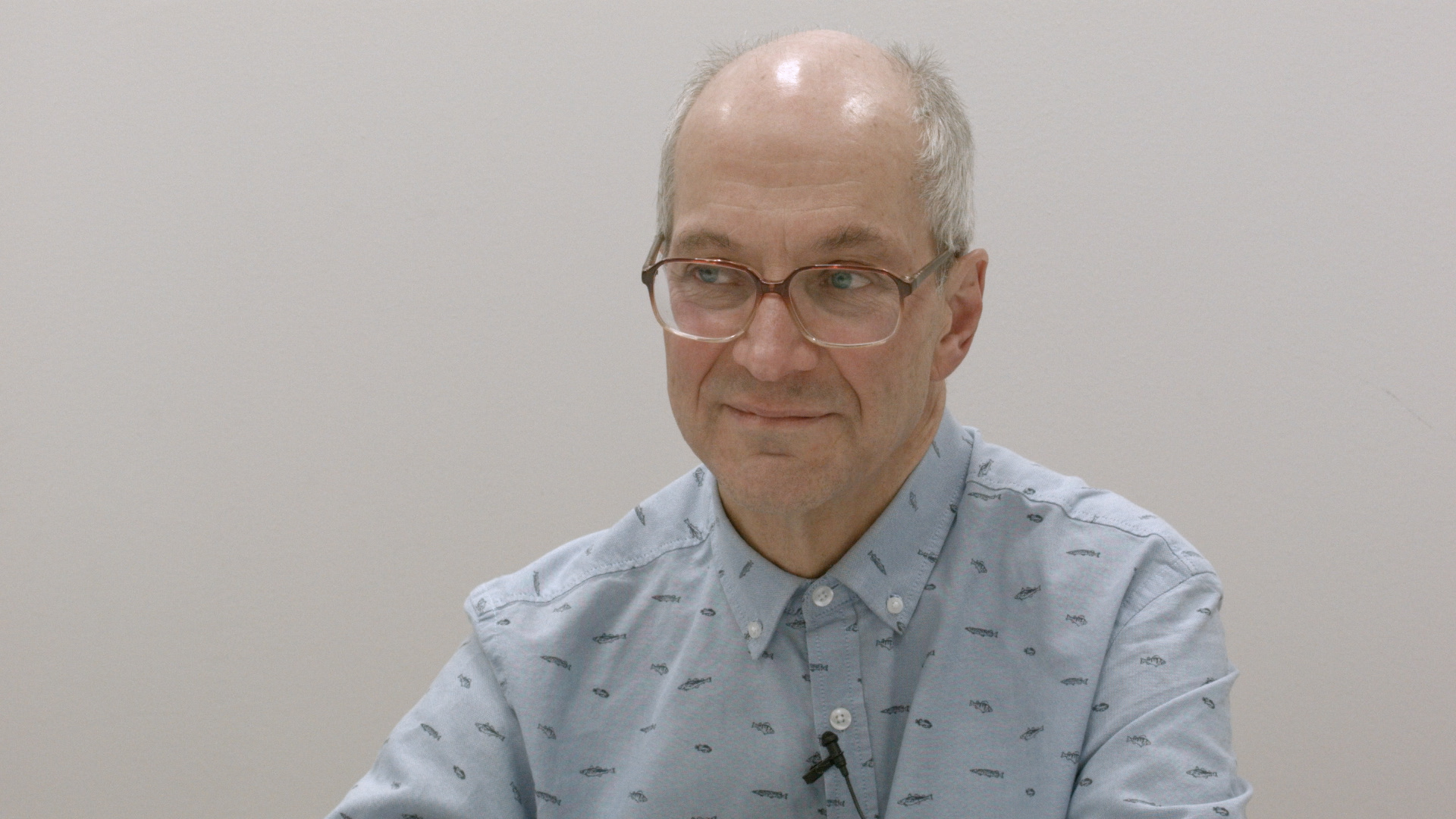
From 1968 to 1987, the BESM-6, the first Soviet super-computer based on the second-generation element base (semiconductor transistors), was mass-produced in the USSR. There were 355 such cars in total. The car at number 32 from 1972 to 1991 was serviced by Alexander Lamden. First as a technician, later as a technician and engineer.
We continue to complement the museum's DataArt collection of IT history interviews. We have already published the stories of Sergey Zonov , the creator of one of the main clones of the Spectrum, and Eugene Kanevsky , who developed the computer and Iskra-226. Alexander Lamden told us about the working day of the computer center, the tasks that Soviet super-computers set, and the fate of these machines.
“Found mine”
- I met computer technology as a teenager. At that time, the 239th school had its own computer — the Ural-1. On it we went through a field trip. Together with the certificate of secondary education, we were issued operator-programmer certificates.

A. A. Lamden in the engine room, behind - BESM-6, the struts BRUS and UU are visible (on the right)
Then everything was much worse. During the summer, I passed the exams four times - once school and three times introductory: at first I did not enter the physics department, then - at the math. Then he entered LITMO, already in the evening. Means, it was necessary to work somewhere. The teacher who taught programming at our school said: "Come to us." “To us” is in “Giproenergomash”. Then they occupied two interesting buildings. One is on Palace Embankment, directly opposite the Peter and Paul Fortress. The second is the Novodevichy Convent. I visited both there and there, sort of agreed on something. And suddenly, my mother said that you need a man in the computing center of the LO CEMI - the Leningrad branch of the Central Economics and Mathematics Institute.
So I got to the operation laboratory and, frankly, I liked it more than at Giproenergomash, although the work is about the same and for the same money. The old building didn’t scare me, because we ourselves lived in a communal apartment, which I used to ride from end to end on a bicycle - not a nursery, no.
In general, I considered this work as a temporary phenomenon. He was going to be transferred to day time, to study humanly. But I liked it so much at LO CEMI that I even changed the specialty of training - I didn’t do computer science at all.
- What did you like?
- This is called "found mine." In general, I have a tendency to pick in all kinds of glands, in devices, to work with a soldering iron. All this was in demand there. Secondly, a very good team was in the data center. Almost homely atmosphere, very friendly - it played a role. I was the youngest employee at the institute, we went on trips to our laboratory to look at me. But I calmly accepted the whole thing.
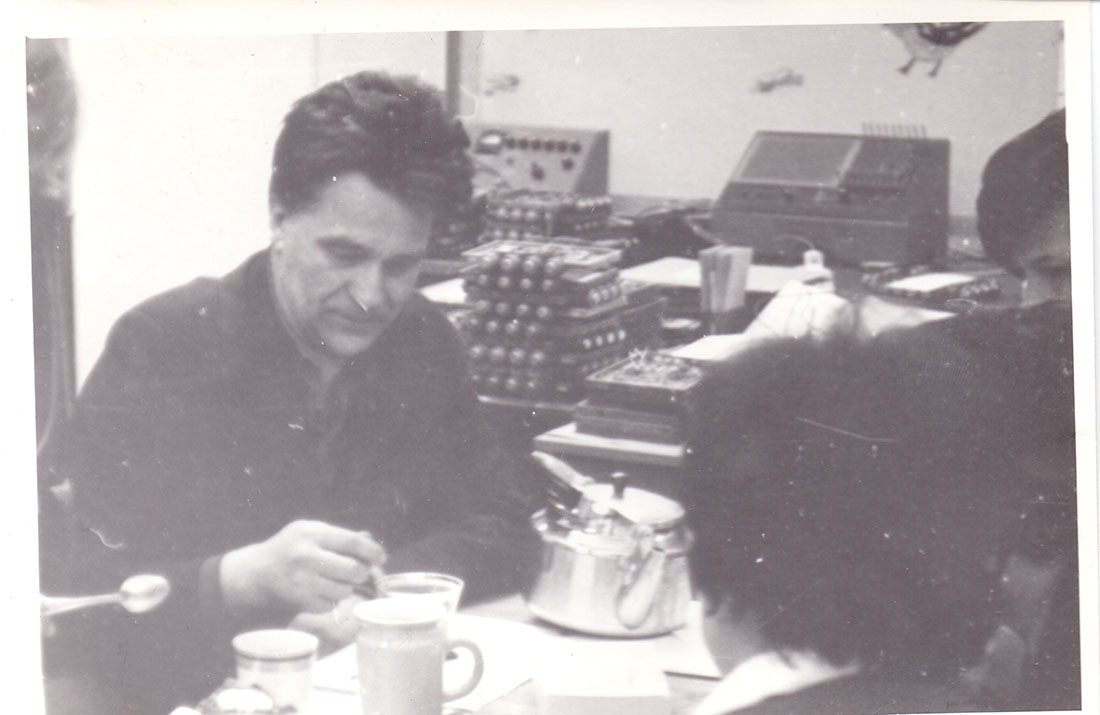
Zavlab E.I. Baskov. Tea drinking with the staff of the Technical Service Laboratory. Photo: Alexander Lamden
From breaking one to breaking two
- After Ural-1, I was not afraid of anything. We fought with him in practice. We ourselves did not repair the car, but it was repaired with us - we were standing nearby. I saw how all this was done, and roughly understood what was happening. But BESM-6 is a technician of a different level.
- Tell us about your work day in the early 1970s.
- A typical day in our computer center, like in others, usually began with morning prophylaxis - input, output devices, storage devices. I will explain what it is about. Input is a punch card. Punched cards are paper. Paper is dust. The perfect punch card is very well made, it has a calibrated thickness, a calendared surface, but there is still paper dust. Because it is prepared on machines that punch holes, the edges of these holes crumble. It must be cleaned - vacuumed, washed.
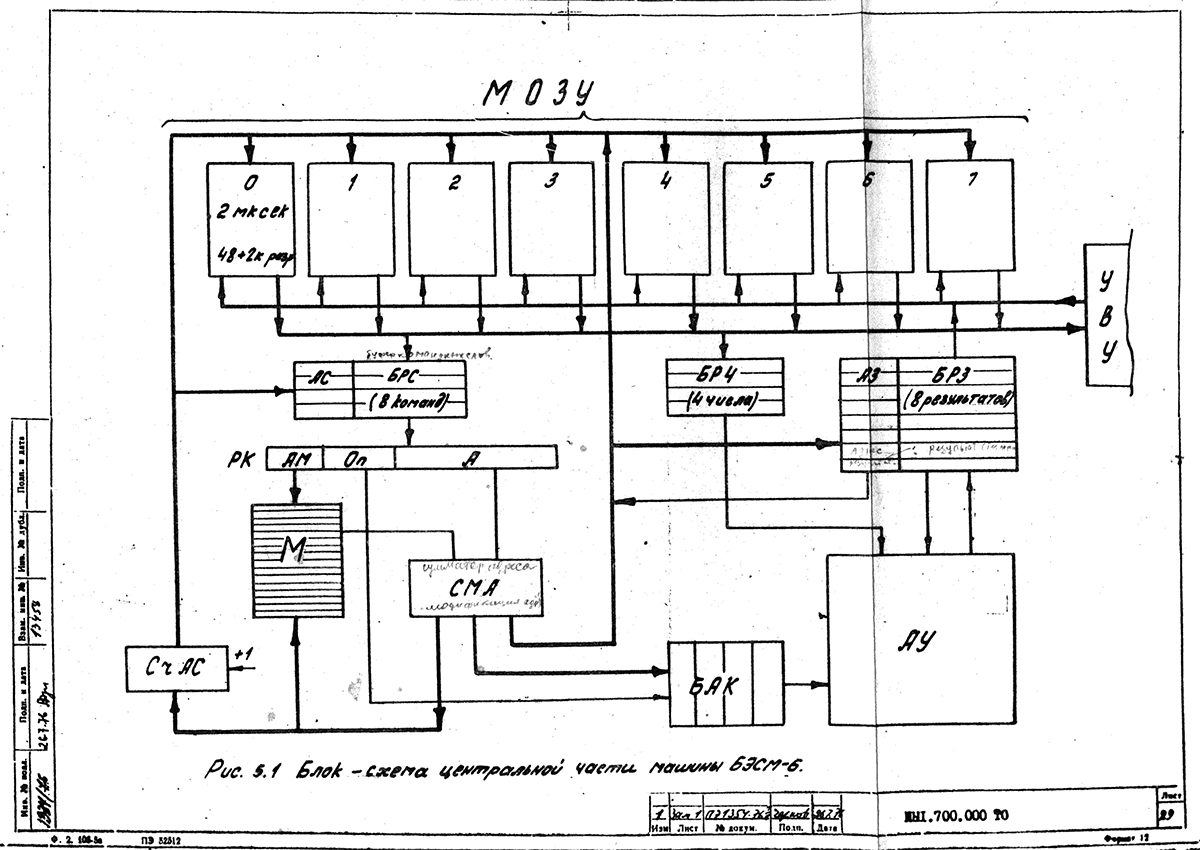
Block diagram of the central part of the machine from the technical description BESM-6
- How to vacuum?
- A vulgar vacuum cleaner. Wipe clean with a cloth with alcohol. Similarly with output devices. The output device is an alphanumeric printing piece with a drum with a good size cabinet. There paper is simpler, more dust. Ink ribbon yet, mechanisms that sometimes disperse and be late. It is necessary to check whether it hits evenly so that the line does not look like Amur waves.
The storage device is on magnetic tape. Tape recorders are not desktop, these are cabinets under two meters high, in which dust also settles, but it should not be. This means that in the morning everything was washed, cleaned, wiped, checked. If there were any complaints from the operators - either an entry in the log, or a “does not work” sign - it means they also dealt with this.
- How long did the morning prophylaxis take?
- They usually made it three or four people, less often two. If everything is fast and there are no complaints, it took half an hour. If more, the device was turned off, not allowed to work and worked on it separately. After that, the car was turned on and they began to figure out what was wrong. That everything worked - it did not happen.
- What did you talk about with your colleagues at lunchtime?
- About how "kerosene flows through the wires." It cannot flow here, along this wire, but it flows. Or vice versa. Must flow, not flow. But not only that was discussed. We had a very diverse company. Some people, for example, could arrange an excursion to the Hermitage or give a tennis master class. Could go camping on a yacht - we had sailors.
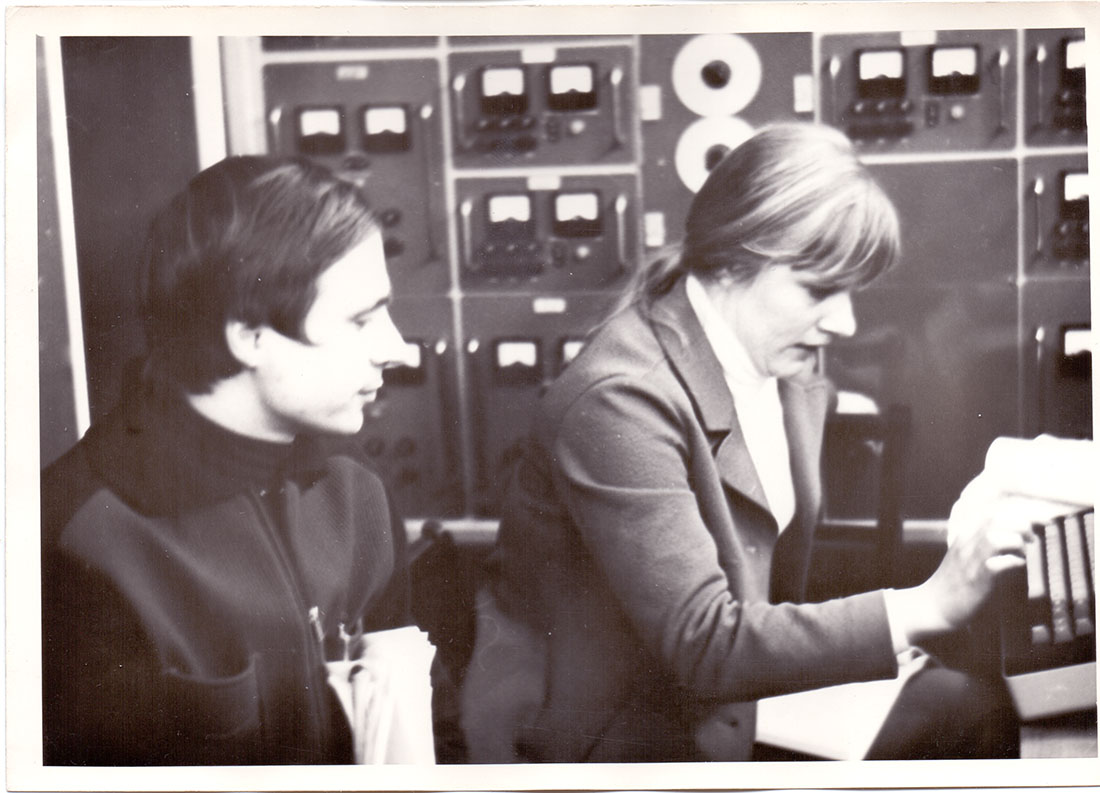
V.P. Alekhin and L.I. Guziy are editing the next version of the test program. In the background is one of the power racks of the MOH. Photo: Alexander Lamden
- Society Cream!
- I would say, not even cream, but the pairs that are above the cream. In general, I rarely met such qualifications of people.
“Created Technique”
- Around this time, a little closer to the end of the 1970s, a new technology began to be introduced - a single family, a single series - EU computers . Compared with BESM, the approach to working with it was fundamentally different. The technical public, which constantly grazed near the machine and, in fact, served it, could not really do anything with it. The unit could be replaced independently, but all heavy sores had to be addressed to a single all-Union service center. Therefore, any more or less serious repair was delayed very much.
At the same time, the technique was not very reliable, it was sensitive to external influences. They learned to make stable machines only in the end, when there was almost no sense in that. But BESM-6, we once did not turn off the whole month: we decided to put an experiment, how much it can work without failures. In general, I have a fairly well-established negative opinion about the machines of the Unified Series, on which all forces and resources were then thrown. Accordingly, the direction of BESM was ruined and not given due attention to what is now called personal machines.
Well, we must admit that the EU computer is a “created technique”, as we said then. Because this is a copy of the IBM 360, and later on - the IBM 370, which means a deliberate lag.
Humanitarian Serpentarium
- What was your position called in the 1970s?
- Technician, senior technician. After the army, he became known as the installer. My responsibilities have expanded, but not because the position is different. It was just in 1975 that the Leningrad academic institutions were greatly shaken up, and then the Institute of Social and Economic Problems arose, into which we were poured.
I came from the army when everything was already done. Before that, some institutes were closed, turned into departments of this very ISEP. Someone was expelled from somewhere, someone, on the contrary, was pushed. Clan struggle, as elsewhere. We looked like a black sheep there (although they were a branch of the Institute of Economics and Mathematics, they had only an indirect relation to sociology and something like that) - the techies were in the humanitarian, as it were, serpentariums. Quite a lot of time passed before they realized that we, too, could give them something.
- What were your tasks?
- Basically, statistical calculations. A sociologist is preparing a survey. Based on this survey, he needs to get some predictions - pure mathematics.
Perhaps the most interesting tasks were related to thermohydrodynamics, urban planning, and transport design. In 1985, a 20-year development plan for the transport network was made. They considered it with us. One of our laboratories worked very closely with Lenproject: passenger flows, calculations. Metro schemes, which are now showing in different places, come from there. That's how it should have looked in 2005. To draw these diagrams, I refilled the plotter with ink.
The same development plan for the Leningrad Metro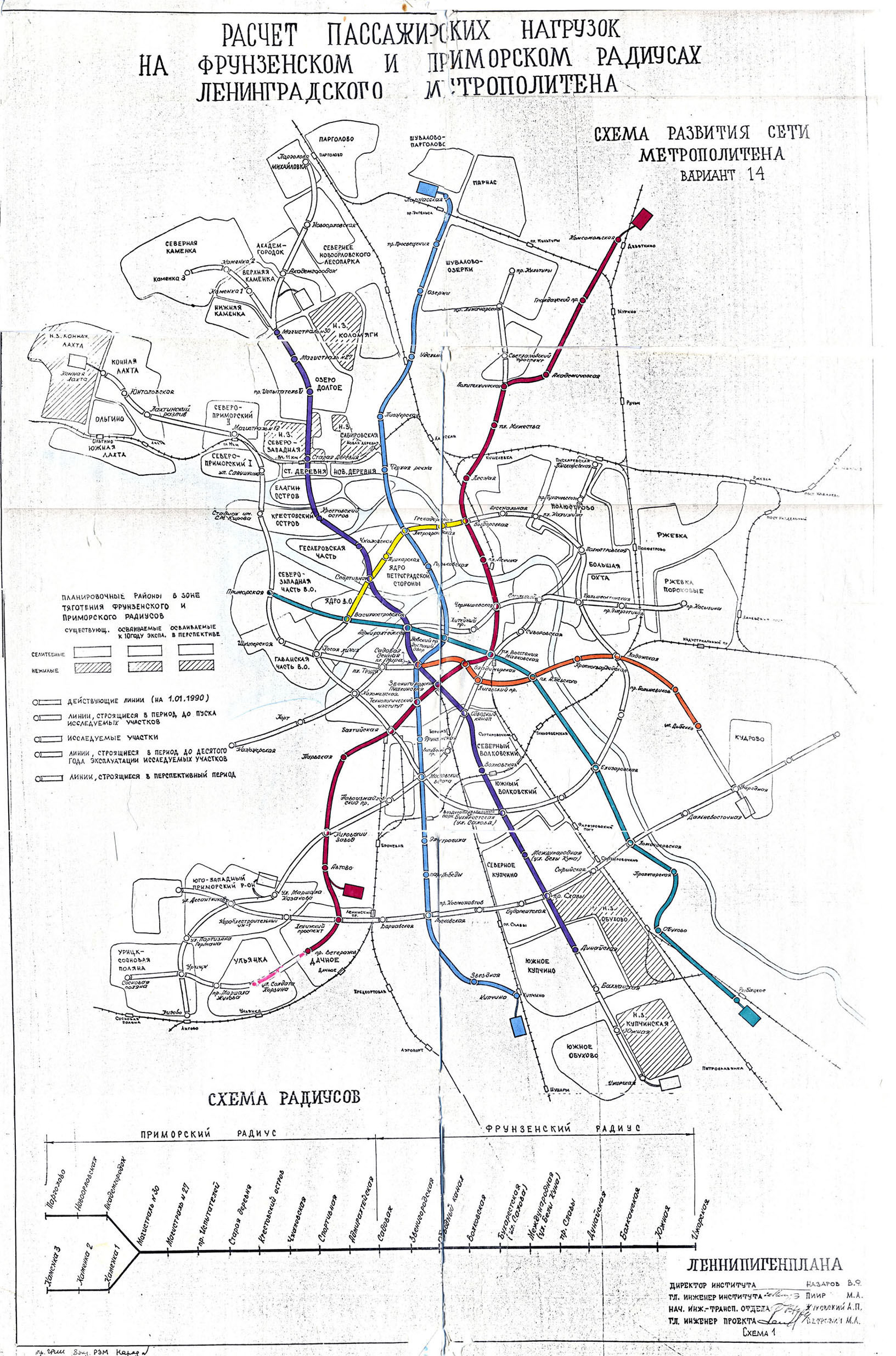

- Be proud?
- I have no pride, unfortunately. More like heartburn. From the fact that it was all profane.
- What are the calculations on thermohydrodynamics?
- For example, the calculation of thermohydrodynamics of Lake Ladoga. Where is what temperature, what pollution, can they get to the Neva, why and when. Will the ice melt, will there be a fish. All primary calculations on the dam in the Gulf of Finland were also done by us. After that, they modeled already on mock-ups. We had no urban planners, no oceanologists, no hydrologists, but there were mathematicians. Mathematics is a universal tool.
Friday and serious business
- How did the breakdowns of the early 1970s differ from the breakdowns of the late 1970s?
- New devices were added, and with them new sores. We have expanded the peripheral network. Some of the devices were connected in the factory way, some - home-made-home-made.
- Over the course of 20 years, have your tasks changed?
- They were about the same. But, having gained experience, I was already engaged not only in dusting and washing, but also in some more interesting things. Such as, for example, connecting freelance devices.
- What kind of devices?
- The current generation probably cannot understand this, because all the devices that you can imagine now have a standard interface. Picked up, the driver downloaded - it works. BESM-6, like other equipment of that time, had a limited set of standard devices, and nothing more. Connecting a foreign element is fraught with the fact that the number of lines, signal levels, and operation algorithms do not meet. This all had to be connected. In some devices had to penetrate quite deeply.
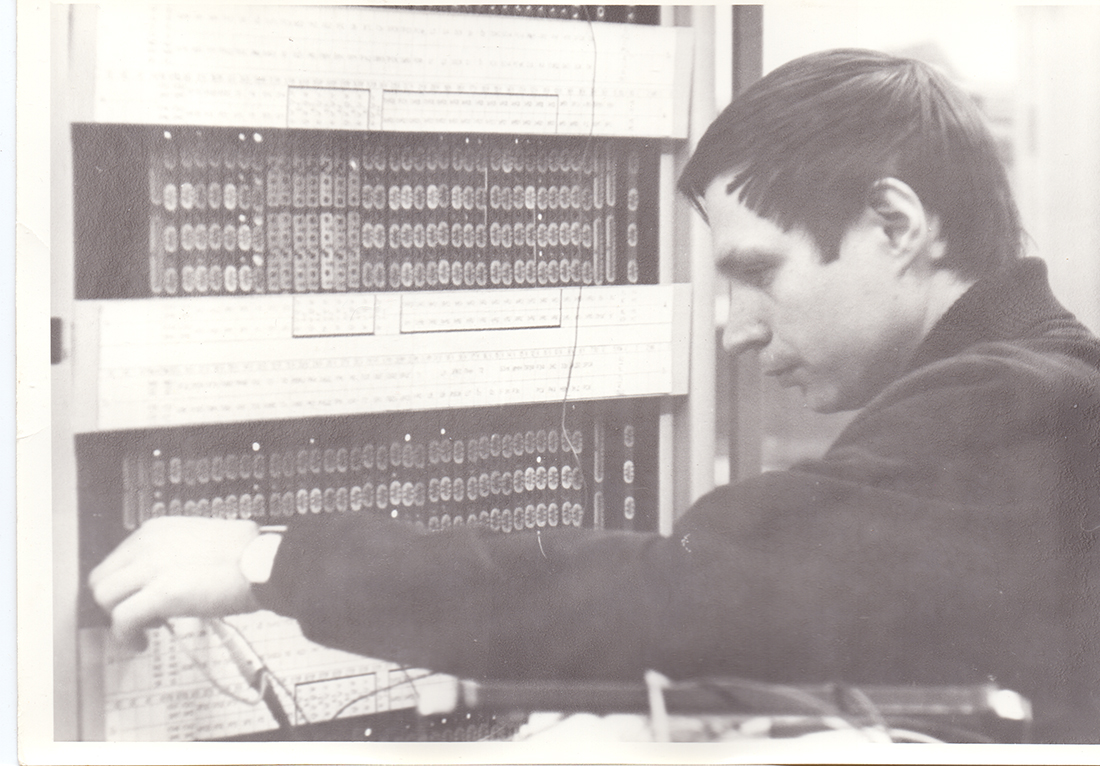
V.P. Alekhin connects the oscilloscope probe to one of the blocks of the KMD rack. Photo: Alexander Lamden - Sat
over such puzzles until midnight?
- Until midnight, we usually did not sit. The puzzles lived in the head and were awakened in a dream - I'm not joking. There were other interesting cases. After one of them, I myself stopped, and forbade my employees to start serious work on Friday afternoon.
We just hooked up another piece of iron and did it together with the Kiev Institute of Cybernetics. The main part of the thinking process was on us, we agreed with them and clarified the scheme, they made the layout, and in the future - a working instance of an intermediate device. Then they brought it to us - to debug it.
Once again, a wonderful guy came from Kiev, brought this thing, we examined it. They spent three days, all is well. It remains to make the last couple of measurements - and he has a plane home. Friday. We went for lunch, came, we begin to measure. Then a crocodile clip flies, flies over the board and something touches. It turned out that this earth clamp is not grounded and there is voltage on it that gets into the circuit.
The car stops, we begin to understand and it turns out that in four or five racks along this chain everything is destroyed. The algorithm for further actions is understandable: you take out one block - insert another, take out - insert. But the serviceable replacement blocks are over. This guy said goodbye to us - he has a plane - and here I am, the head of the car and got six hands with three soldering irons until the end of Sunday repairing the blocks. You can't start serious business on Friday!
In general, technology should be treated not only with respect, but with the understanding that it has its own life. They say that artificial intelligence is still far away, but any piece of iron, even a fountain pen, has a character. Especially complicated technique. A primitive example: you need to leave work early, for 10 minutes literally. You put on your shoes - the door opens: "And our car got up!" You take off your shoes, you go to repair.
Another case. Everything is fine, the car is working, but you decide to correct something insignificant. At this time, something stops working elsewhere. When there were several such cases - “get away early” and “approached the car, it broke” - he said in a zealous mood: “Put a cot here for Lamden and keep him out of the car!”
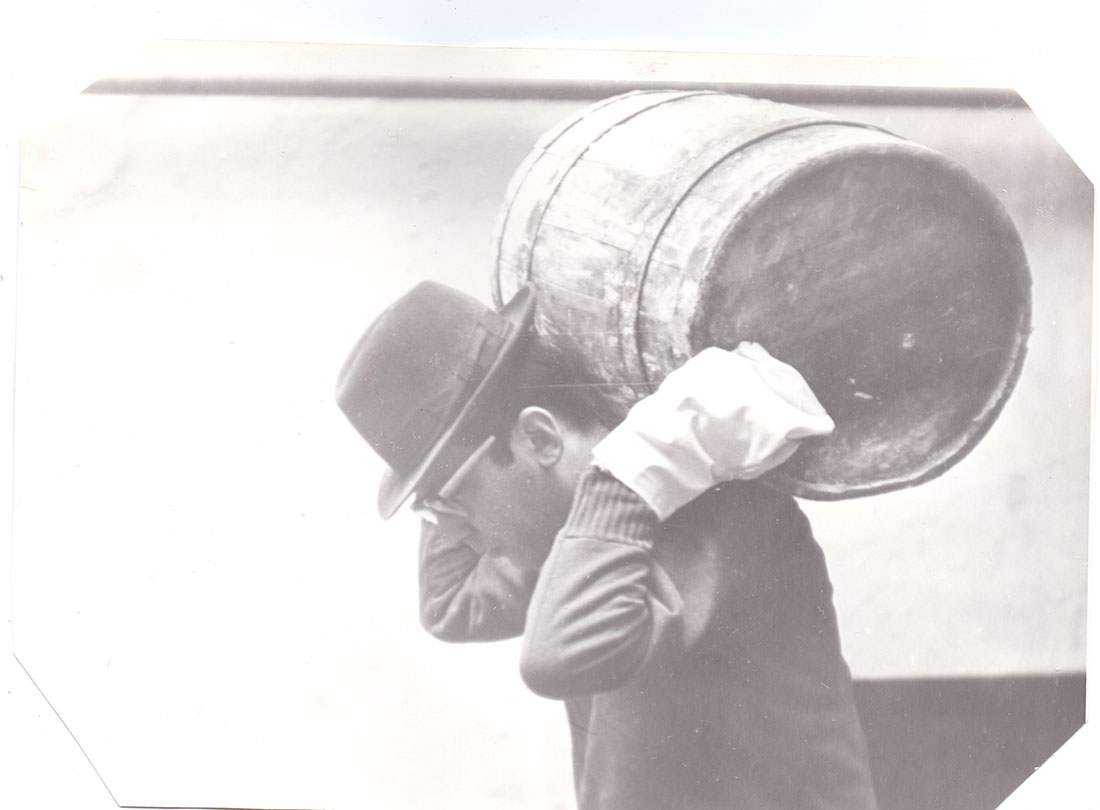
S. V. Sivashinsky, ISEP Junior Researcher, during a general business trip to a collective farm. Photo: Alexander Lamden
Recent years BESM-6
- Almost to the very end, we developed our piece of iron, led to a more modern look. But perestroika, which turns into a skirmish, very much undermined everything. Financing of work in computer technology was virtually discontinued.
Somewhere in the year 1987, we went to Moscow without a trace to look at a car that could replace the BESM-6. She already worked, tests were conducted. But they did not give money. All. Now that plant is huddled on two floors of one building, the remaining premises are a business center.
- What kind of car did you go to watch?
- It was based on a modern elemental base, the principles of construction and architecture have slightly changed. The series was called "Elbrus". And the guys really planned a series - from supercomputers to desktop machines that were software compatible. That is, it was possible to debug programs on your desk, and send serious calculations to super-computers, and there was no need to change anything in the program.
- In 1987, you worked to launch this?
- Yes. But already at that time it was clear that everything was bad. The last at that time EU cars were pulled up, all funding went there. After I came across personal computers, it became clear that the BESM-6 has lived on in recent years. Because computing power has already become more or less commensurate. Moreover, BESM-6 is a huge machine room, an impressive auxiliary room with fine filters, with an oil filter, with irrigation. If you describe all this to anyone who understands air conditioning systems, he will be very impressed. Together with the numerous personnel who had to constantly jump around the machine, it was already becoming completely unbearable.
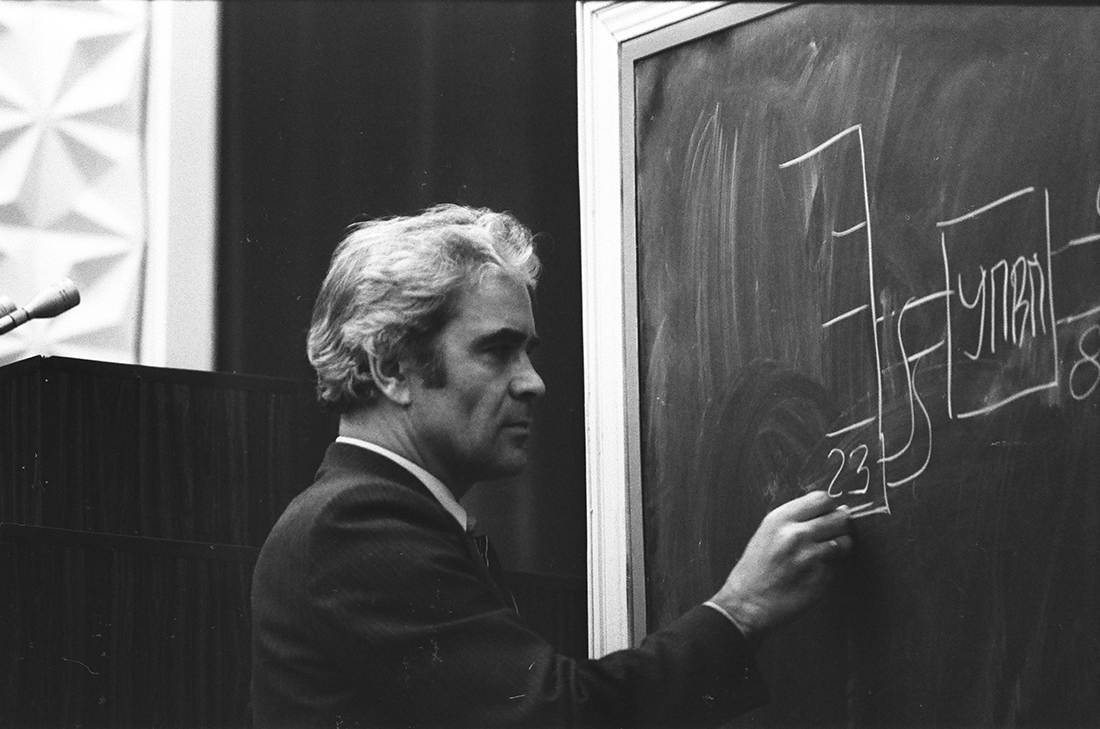
April 1986 Conference on BESM-6 at the Leningrad Institute of Nuclear Physics (Gatchina). Photo: Alexander Lamden
- People began to be fired?
- I left earlier. The audience that remained to be finalized was already near retirement or retirement age. At the same time, there was a reprofiling for some tasks related to personal equipment. When the institute is full of staff, they need to be combined into a network, a server must be installed, some kind of connection established, common printers made. I was invited to another place. (In 1991, Alexander Lamden worked in the specialty at the Saint-Petersburg Commodity Stock Exchange, then 20 years at the processing center of Petrovsky Bank. - Ed.)
- Is it hard to leave work that I devoted 20 years to?
- On the one hand, it’s very difficult, on the other - it’s easy. I understood that all this has been surviving in recent years, and what is next is unclear. The time was already hard. I did not experience problems with my salary, I was even raised, but I understood that this was not for long.
- What is now in place of your computer center?
- When the employees were transferred to the personal computers, they did something like a lecture hall in the engine room. Then they survived from there. This is such an attractive place - the corner of Tchaikovsky and Fontanka - the very center of St. Petersburg, the former famous school of law.
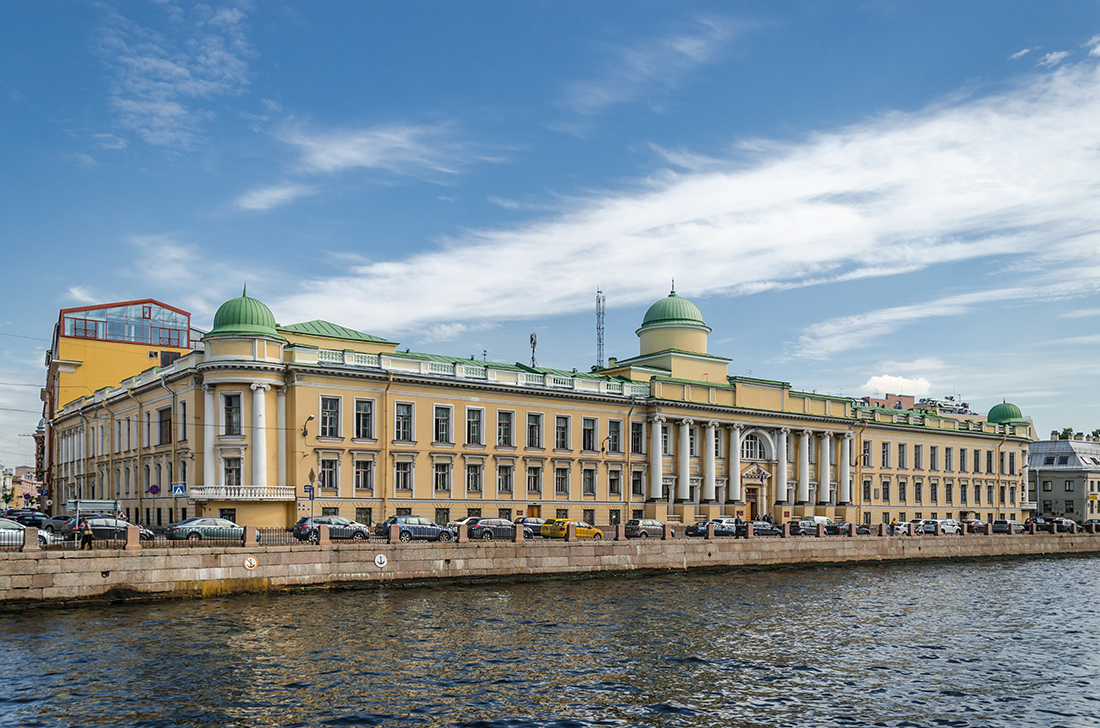
The building of the former Imperial School of Law is now occupied by the Leningrad Regional Court
- What do you like most in your profession?
- Make the machine work. When a cold corpse begins to live, it's nice. This applies not only to computer technology - to any piece of hardware. Go through a bike, for example. Sometimes I found defects in cars and cars that the workshop could not find.
- Is it true that gold was obtained and sold from BESM?
- They didn’t get it themselves - they handed over the blocks to the appropriate place. Almost 2 kilograms of gold were smeared on BESM-6. But it is smeared in such a thin layer that it is impossible to peel it off; a special process is needed. There were firms that did this. And now you can find ads: "We accept connectors, microcircuits." Silver, gold, palladium. When you have one phone or computer - it's about nothing, there are fractions of a gram. When gold is 2 kilograms, this is already an industrial scale. They handed over blocks, received money, bought personal computers for them and continued to work.
Even when everything worked well for us, BESM-6 was already thrown out at the Leningrad Institute of Nuclear Physics in Gatchina (Institute of Nuclear Physics). I was asked to go see if there was anything there that could be useful for us to operate. And I can say, I turned out to be with good friends at the funeral. When they began to disassemble our car, they invited me, but I did not go. In order not to break something that had been blowing dust for 20 years.
